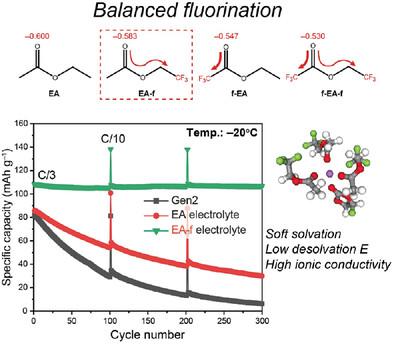当前位置:
X-MOL 学术
›
Adv. Energy Mater.
›
论文详情
Our official English website, www.x-mol.net, welcomes your
feedback! (Note: you will need to create a separate account there.)
Rational Design of Fluorinated Electrolytes for Low Temperature Lithium-Ion Batteries
Advanced Energy Materials ( IF 24.4 ) Pub Date : 2023-04-09 , DOI: 10.1002/aenm.202204182 Dong‐Joo Yoo 1 , Qian Liu 1 , Orion Cohen 2 , Minkyu Kim 1 , Kristin A. Persson 3, 4 , Zhengcheng Zhang 1
Advanced Energy Materials ( IF 24.4 ) Pub Date : 2023-04-09 , DOI: 10.1002/aenm.202204182 Dong‐Joo Yoo 1 , Qian Liu 1 , Orion Cohen 2 , Minkyu Kim 1 , Kristin A. Persson 3, 4 , Zhengcheng Zhang 1
Affiliation

|
Nonaqueous carbonate electrolytes are commonly used in commercial lithium-ion battery (LIB). However, the sluggish Li+ diffusivity and high interfacial charge transfer resistance at low temperature (LT) limit their wide adoption among geographical areas with high latitudes and altitudes. Herein, a rational design of new electrolytes is demonstrated, which can significantly improve the low temperature performance below −20 °C. This electrolyte is achieved by tailoring the chemical structure, i.e., altering the fluorination position and the degree of fluorination, of ethyl acetate solvent. It is found that fluorination adjacent to the carbonyl group or high degree of fluorination leads to a stronger electron-withdrawing effect, resulting in low atomic charge on the carbonyl oxygen solvating sites, and thus low binding energies with Li+ ions at LT. The optimal electrolyte 2,2,2-trifluoroethyl acetate (EA-f) shows significantly improved cycle life and C-rate of a NMC622/graphite cell when cycled at −20 °C and −40 °C, respectively. In addition to superior LT performance, the electrolyte is nonflammable and tolerant for high voltage charging all owing to its fluorine content. This work provides guidance in designing next-generation electrolytes to address the critical challenge at subzero temperatures.
中文翻译:

低温锂离子电池含氟电解质的合理设计
非水碳酸盐电解质常用于商用锂离子电池 (LIB)。然而,低迷的李+低温 (LT) 下的扩散性和高界面电荷转移阻力限制了它们在高纬度和高海拔地区的广泛应用。在此,证明了新型电解质的合理设计,可以显着提高-20°C以下的低温性能。该电解质是通过调整乙酸乙酯溶剂的化学结构,即改变氟化位置和氟化度来实现的。发现与羰基相邻的氟化或高氟化度导致更强的吸电子效应,导致羰基氧溶剂化位点上的原子电荷低,因此与 Li + 的结合能低LT 处的离子。最佳电解质 2,2,2-三氟乙酸乙酯 (EA-f) 分别在 -20 °C 和 -40 °C 下循环时,NMC622/石墨电池的循环寿命和 C 倍率显着提高。除了出色的 LT 性能外,由于其氟含量,电解液不易燃并且可以承受高压充电。这项工作为设计下一代电解质以应对零下温度下的关键挑战提供了指导。
更新日期:2023-04-09
中文翻译:

低温锂离子电池含氟电解质的合理设计
非水碳酸盐电解质常用于商用锂离子电池 (LIB)。然而,低迷的李+低温 (LT) 下的扩散性和高界面电荷转移阻力限制了它们在高纬度和高海拔地区的广泛应用。在此,证明了新型电解质的合理设计,可以显着提高-20°C以下的低温性能。该电解质是通过调整乙酸乙酯溶剂的化学结构,即改变氟化位置和氟化度来实现的。发现与羰基相邻的氟化或高氟化度导致更强的吸电子效应,导致羰基氧溶剂化位点上的原子电荷低,因此与 Li + 的结合能低LT 处的离子。最佳电解质 2,2,2-三氟乙酸乙酯 (EA-f) 分别在 -20 °C 和 -40 °C 下循环时,NMC622/石墨电池的循环寿命和 C 倍率显着提高。除了出色的 LT 性能外,由于其氟含量,电解液不易燃并且可以承受高压充电。这项工作为设计下一代电解质以应对零下温度下的关键挑战提供了指导。






























 京公网安备 11010802027423号
京公网安备 11010802027423号